
498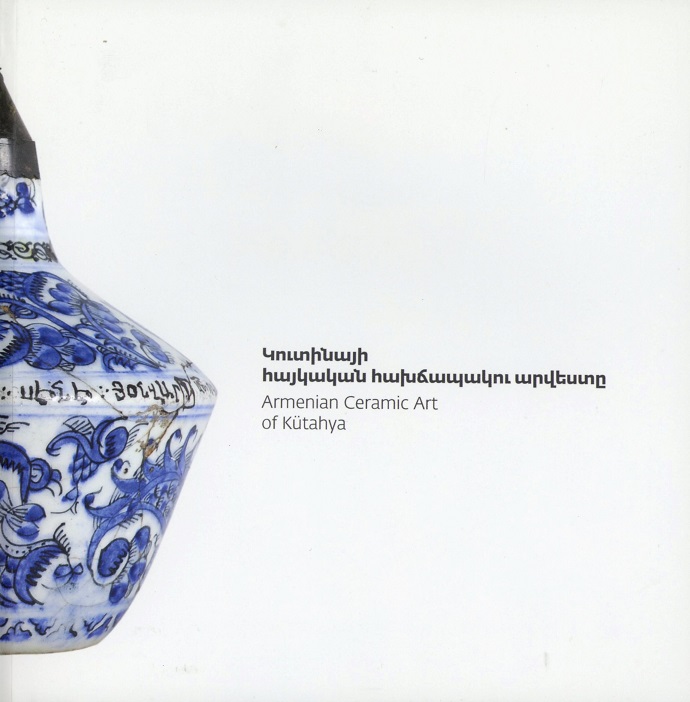 Rangement général
 | | Armenian ceramic art of Kütahya |
| Titre : | Armenian ceramic art of Kütahya / auteur(s) : Catalogues - |
|---|
| Editeur : | Komitas Museum-Institute |
|---|
| Année : | 2016 |
|---|
| Imprimeur/Fabricant : | Printinfo - Yerevan |
|---|
| Description : | 20 x 20 cm, 177 pages, couverture illustrée en couleurs |
|---|
| Collection : | |
|---|
| Notes : | Bilingue arménien-anglais |
|---|
| Autres auteurs : | |
|---|
| Sujets : | |
|---|
| ISBN : | 9789939913414 |
|---|
| Lecture On-line : | non disponible |
|---|
Commentaire :This catalogue accompanies the exhibition The Armenian Ceramic An ofKutahya, held at Komitas Museum-Institute from September 2Oth to December 2Oth, 2016. The pottery, presented in the exhibition and in this catalogue came from collections of two public museums of Armenia (Mother See of Holy Etchmiadzin and Memorial Complex of Sardarapat Battle. The National Museum of Armenian Ethnography and History of Liberation Struggle in the Armavir region) and private collections of two families (Karakashian and Minassian). These exhibits represent a small fragment of the history of the Armenian ceramic art of Kutahya. Exhibition team
Scientific editor: Dickran Kouymjian
Scientific adviser: Marine Haroyan
Curator: Nairi Khatchadourian
Designers: Sarhat Petrosyan, NaneToumanian
Photographer: Cevorg Perkuperkyan
Armenian text proofreader: Karine Rafaelian
English text proofreader: Vladimir Ter-Chazaryan Catalogue team
Editor: Nairi Khatchadourian Designer: Nane Toumanian Photographer: Cevorg Perkuperkyan Eastern-Armenian text proofreader: Karine Rafaelian Western-Armenian text proofreader: Ani Prtoian Ghazarian English text proofreader: Vladimir Ter-Ghazaryan Special thanks for the exhibition and catalogue preparation to: Father Ter Asoghik Karapetian and the staff of the Mother See of Holy Etchmiadzin museum, Karen Aristakesian and the staff of the Memorial Complex of Sardarapat Battle. National Museum of Armenian Ethnography and History of the Liberation Struggle, Suzanne Babey, Neshan Balian, John Carswell, Yolande Crowe, Emma Harutyunyan, Nubarand Meline Karakashian, Hrair Hawk Khatcherian, Dickran Kouymjian, Garo Kurkman, Mihran Minassian, Sato Moughalian, Varazdat Panoyan, Nirit Shaleh-Kharfa, Laure Soustiel.
Published with the support of Pyunik Charitable foundation |
331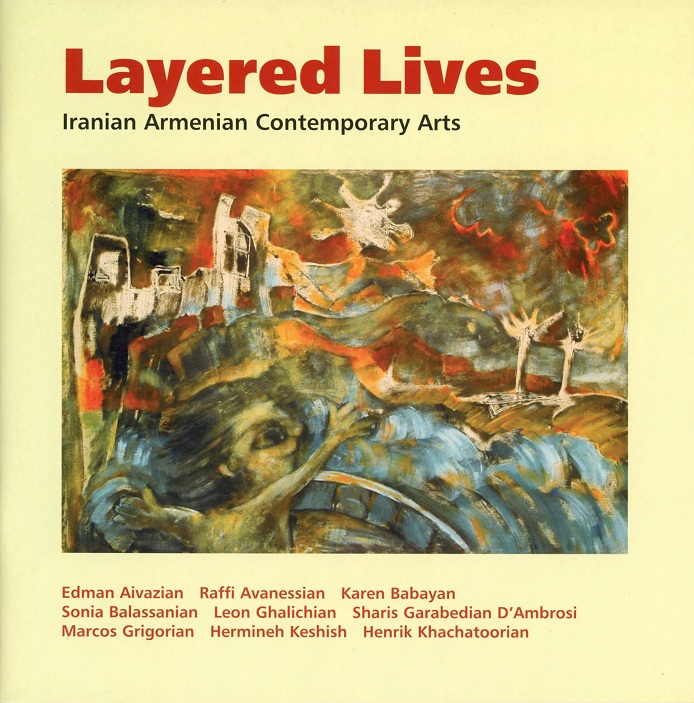 Rangement général
 | | Layered lives : Iranian Armenian contemporary arts |
| Titre : | Layered lives : Iranian Armenian contemporary arts / auteur(s) : Catalogues - |
|---|
| Editeur : | armenian institute |
|---|
| Année : | 2006 |
|---|
| Imprimeur/Fabricant : | |
|---|
| Description : | 20 x 20 cm, 24 pages, cover photo in colors |
|---|
| Collection : | |
|---|
| Notes : | Published to accompany the exhibition at the Brunei Gallery (SOAS) London, 25 April to 24 June 2006 |
|---|
| Autres auteurs : | |
|---|
| Sujets : | Exhibition |
|---|
| ISBN : | 0954360915 |
|---|
| Lecture On-line : | non disponible |
|---|
Commentaire :Welcome 5
By Dr Susan Pattie
Between Now and an Unknown Future 6
By Veronica Castro and Dr Abdollah Guivian
About the Artists 8
By Nairi Sahakian
Armenians in Iran 11
By Professor Theo van Lint
Arts and Armenians in Iran 12
Artists 16
Edman Aivazian
Raffi Avanessian
Karen Babayan
Sonia Balassanian
Leon Ghalichian
Sharis Garabedian D'Ambrosi
Marcos Grigorian
Hermineh Keshish
Henrik Khachatoorian
Map inside back cover |
38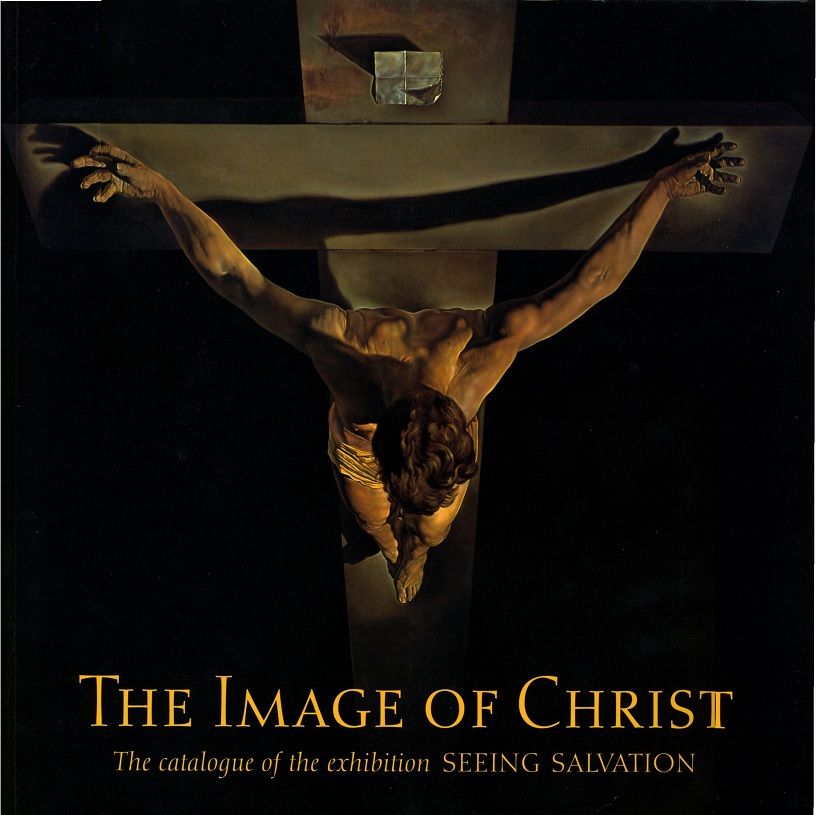 Rangement général
 | | The image of Christ |
| Titre : | The image of Christ / auteur(s) : Catalogues - The catalogue of the exhibition Seing salvation, at the National Gallery, London, 26 February - 7 May 2000 |
|---|
| Editeur : | National Gallery London |
|---|
| Année : | 2000 |
|---|
| Imprimeur/Fabricant : | Butler and Tanner, GB |
|---|
| Description : | 25 x 25 cm, 224 pages, couverture illustrée en couleurs |
|---|
| Collection : | |
|---|
| Notes : | |
|---|
| Autres auteurs : | |
|---|
| Sujets : | Religious painting |
|---|
| ISBN : | 9781857092929 |
|---|
| Lecture On-line : | non disponible |
|---|
Commentaire :Christianity has been such a predominant force in the shaping of European culture it is hardly surprising that so many of the greatest paintings in the National Gallery and elsewhere are of Christian subjects. Yet to many people who come to see these works, who do not share these religious beliefs, their content can seem puzzling or irrevocably remote. But they were the artists' central concern.
This book, and the exhibition it accompanies, expresses the confidence that modern secular audiences can engage with the masterpieces of Christian art at an emotional as well as a purely aesthetic or historical level. Their aim is to help the viewer understand these pictures by focusing attention on the purpose for which they were made, and exploring what they might have meant to their original viewers.
Rather than presenting the life of Christ in art, The linage of Christ looks at the difficulties Christian artists have had to confront when representing Jesus - God who became a man. The authors discuss the astonishing fact that, although we have no contemporary records of Christ's appearance, we all know what he looked like. They tell the story of how this image evolved over two millennia, starting with the earliest symbols and metaphorical images such as the Shepherd, the Lamb and the Vine. They trace the emergence of a 'true likeness', emphasising the importance of the Veronica, the 'miraculous portrait' said to have been imprinted on the cloth held out to Jesus on the way to Calvary. They describe how artists conveyed the paradox of Christ's dual nature - human and divine, weak and powerful, victim and victor - in portrayals of his infancy. They also show how images of Christ's suffering during the Passion were intended to convey a cosmic, not just a personal significance. It is through art that Christian artists have attempted to put extremes of suffering and despair into an overall context of hope - a vein of hope that runs from the catacombs to Hiroshima and beyond.
These are images that speak even to those who do not hold Christian beliefs. Artists had to make it clear that in representing the life and death of Jesus they were offering a continuing truth; we the spectators have to become eye-witnesses to an event that matters to us now. As a result, the different moments and aspects of Christ's life become, in the hands of great artists, archetypes of all human experience. The Virgin nursing her son expresses the feelings of love every mother has for her child. Christ mocked is innocence beset by violence. Christ risen and appearing to Mary Magdalene is a universal reaffirmation that love cannot be destroyed by death. These are pictures that explore truth not just for Christians, but for everyone. |
217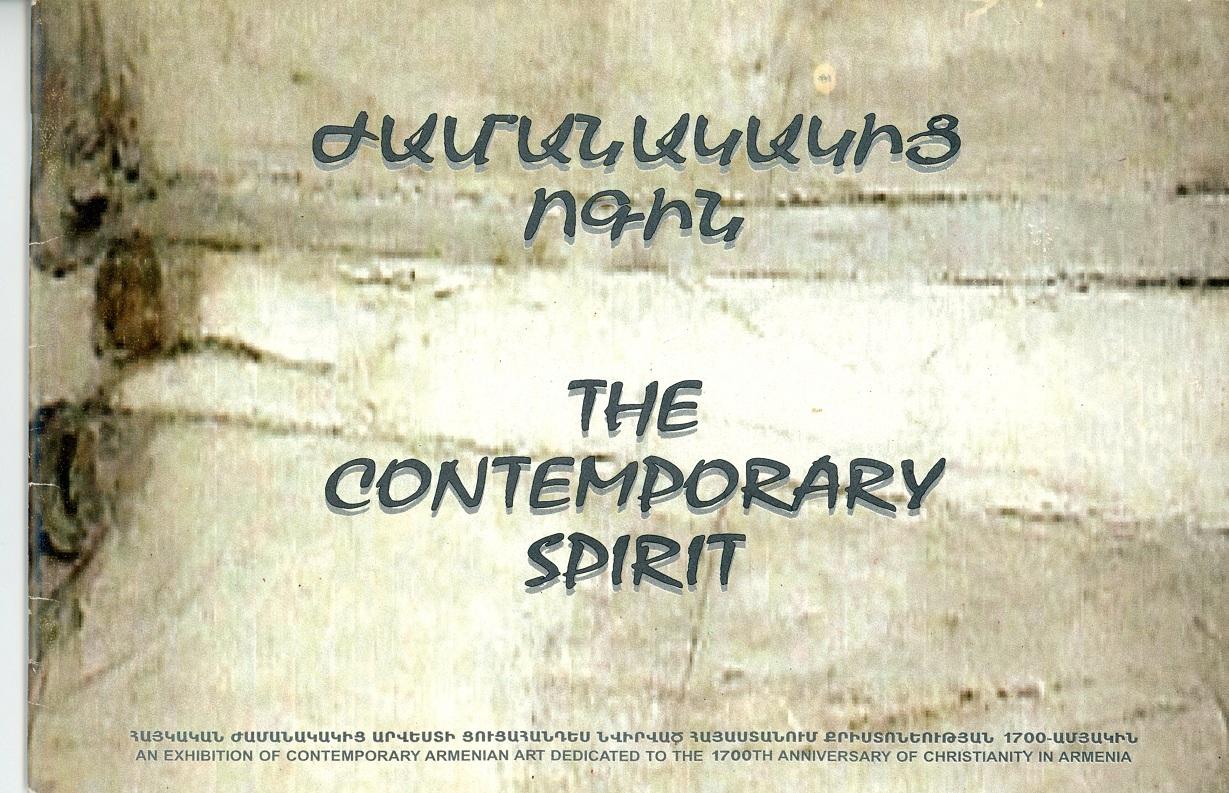 Rangement général
 | | The contemporary spirit |
| Titre : | The contemporary spirit / auteur(s) : Catalogues - An exhibition of contemporary Armenian art dedicated to the 1700th anniversary of Christinaity in Armenia |
|---|
| Editeur : | Etchmiadzin |
|---|
| Année : | 1998 |
|---|
| Imprimeur/Fabricant : | Etchmiadzin |
|---|
| Description : | 29 x 18,5 cm, 36 pages, couverture illustrée en couleurs |
|---|
| Collection : | |
|---|
| Notes : | August 27- eSeptemebr 4, 1998, at the Gevorgian seminary of the Mother See of Holy Etchmiadzin |
|---|
| Autres auteurs : | |
|---|
| Sujets : | Armenian contemporary paintings |
|---|
| ISBN : | |
|---|
| Lecture On-line : | non disponible |
|---|
Commentaire : |
575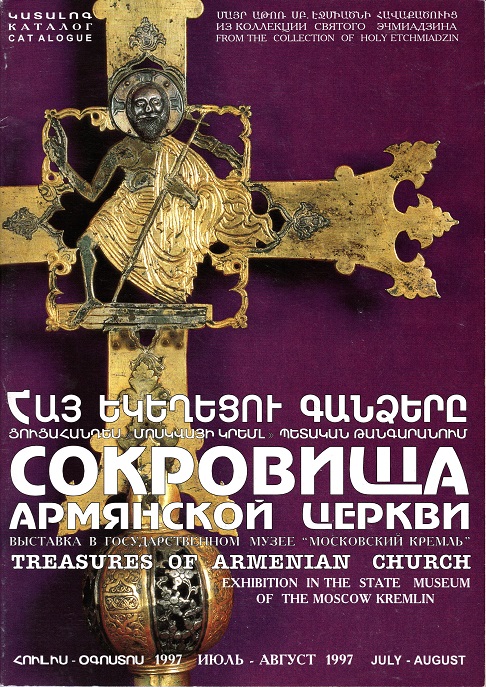 Rangement général
 | | Treasures of Armenian Church |
| Titre : | Treasures of Armenian Church / auteur(s) : Catalogues - Exhibition in the State Museum of the Moscow Kremlin (July-August 1997) |
|---|
| Editeur : | Saint-Siège d'Etchmiadzine |
|---|
| Année : | 1997 |
|---|
| Imprimeur/Fabricant : | Raster's Print and Publishing, Moscow |
|---|
| Description : | 21 x 29, 147 pages, broché, couverture illustrée en couleurs, index (uniquement en russe), illustrations couleurs pages 32 à 126, texte trilingue,arménien/russe/anglais |
|---|
| Collection : | |
|---|
| Notes : | Document unique, ouvrage introuvable. Don de Keham Torossian ; Dédicace de S.S. Karékine Ier à Kegham Torossian |
|---|
| Autres auteurs : | |
|---|
| Sujets : | Catalogue d’exposition d'objets des collections d'Etchmiadzine |
|---|
| ISBN : | |
|---|
| Lecture On-line : | non disponible |
|---|
Commentaire :SEVENTEEN CENTURIES OF CHRISTIAN WITNESS THROUGH ART AND CULTURE Religion and art have gone hand in hand all along human history. It is a historically established fact that religion was the birthplace of human artistic creativity.
Christianity could not make an exception. From the earliest stages of its historical origins, Christian religion became a rich source of inspiration and development for music, vocal and instrumental, painting, carving, building with norms of aesthetic nature. From the Catacombs of Rome to the rock-cut and cave-form chapels of Cappadocia, Christian art became inherent part of Christian life, creativity and witness. The so-called Minor Arts or Applied Arts occupied also an important part in religious artistic tradition.
Armenia, one of the first countries where Christianity was preached beginning from the first century, and where Christian religion was proclaimed as the State Religion of the Armenian nation in 301, the Christian faith became the driving force behind all cultural creativity in the formation process of what is known as Arnenian civilization.
The very name of Etchmiadzin, the spiritual center of the Armenian Church, is jdentified with a mystical moment full of the power of spiritual transfiguration of what is purely material. And this, i.e. the transfiguration power, to my understanding, constitutes the very essence of all arts of true nature and genuine authenticity. For, Etchmiadzin in Armenian means "The descent of the Only-Begotten Son". The historical record as registered in the famous book of Agathangelos (sections 731 to 736) describes in a masterly literary style the vision of St. Gregory called the Illuminator, the patron saint of the Arrnenian Church, according to which Christ descended from the heavens in a luminous cloud, with a golden hammer in hand, and knocked the ground in the capital city of Vagharshapat where to build His Church. Thus, Etchmiadzin became, so to speak, the birthplace of the Armenian people as a Christian Nation, — as I like to use the expression the "Armenian Bethlehem" for the people of the country of Mount Ararat.
From that first year of the 4th century Etchmiadzin became the spiritual power-house of the Armenian people, the most highly venerated shrine, the "holiest of holies" and the source of spiritual sustenance for the Armenian people in the motherland of Armenia and in the world-wide Diaspora.
Etchmiadzin itself and all the churches, monasteries spread all over the territory of Armenia in the course of subsequent centuries became also centers of spiritual, literary, theological, philosophical scientific, cultural and artistic creative productivity.
Beginning from the creation of the Armenian alphabet in 406 by the monk St. Mesrob Mashtots and the translation of the Holy Scriptures and of the liturgical and patristic literature from Greek and Syriac into Armenian, under the enlightened guidance of Catholicos St. Sahak, the Armenian culture acquired its distinct image and national character by being profoundly impregnated by the highest spiritual values of the Biblical tradition and early Christian (Greek and Syriac) culture.
Besides literature, architecture and miniature or the art of manuscript illumination, sculpture (particularly the art of carving tombstones and memorial stones with the sign of the Cross and other motifs of artistic ornamental design known under the word "Khatchkar"), and music were among the most favoured and rapidly developing arts sponsored, cultivated and promoted by the Church.
The Minor Arts in woodwork, needlework, metalwork were very extensively used for such objects and material which had a liturgical function or served sacred purposes in the life and spirituality of the Church people. Indeed, one is amazed as one goes around the four museums within the precincts of the monastery of Holy Etchmiadzin and sees such a variety of art work related to religious purposes, Church services, and popular piety. One has to realize that what is exhibited in this domain of artistic creation is only a very small, indeed, a tiny portion of what has survived from centuries of destruction, pillaging, robbing and plundering. In Yerevan museums and in "Matenadaran" there is ample evidence of the immeasurable richness of the Armenian religious art in all its various branches and aspects.
It is important to note also that outside of Armenia the second richest center for such Armenian religious art is the Armenian Patriarchate of Jerusalem, where for centuries such treasures have been well preserved. Next to Jerusalem, the Armenian Patriarchate of Constantinople, the Mekhitarist Order and Convent of San Lazzaro in Venice, the Catholicosate of Cilicia (in Antelias, Lebanon), the All Saviour's convent in New-Julfa, Isfahan (Iran), the Armenian Catholic convent of Bzommar (Lebanon) and the Vatican Library and other cultural institutions around the world are holders of such treasures of inestimable value for the ensemble of Armenian civilization.
Historically speaking, Armenia has not been a great nation in terms of political power, economic prosperity, military strength. Its value has been distinctly and eloquently revealed through its culture which has been very deeply imbued by the spirit of the Christian faith kept alive and creative thanks to the perseverant work of the Armenian Church all along the centuries of tribulation and trial that have befallen upon its destiny.
On the occasion of the 17th centenary of the official acceptance of Christianity as the State religion of Armenia (301 A.D.), a number of exhibitions will be organized in different parts of the world, with a definite purpose of making the cultural treasures of the Armenian church and nation available to the people both Armenian and non-Armenian, who have a lively interest in such services that the Armenian Church through its artistic creativity has rendered to human civilization at large.
An Executive Committee is in charge of the organization and coordination of such exhibitions. The one that is presented in Moscow at the Kremlin, is the first in the series, which is jointly sponsored by us and by our beloved brother in Christ His Holiness Alexy II, the Patriarch of the Russian Orthodox Church. It is most appropriate that this first one takes place in Moscow because in the last three centuries the cultural relationship between Russia and Armenia has been one of the dominant aspects in Armenian history and culture.
Todayboth countries, the Federal State of Russia and the Republic of Armenia, after the collapse of the SovietUnion, have entered a new era of close friendship, mutual solidarity and cultural relationship in conditions of freedom that are so conducive to cultural progress.
But our spectrum of thought and desire goes further. We believe that the 1700th anniversary of the official formation of the Armenian Church will turn in the first place into a moment and a movement of spiritual and cultural renewal for our entire Armenian nation in the motherland and in the Diaspora. Seventeen centuries of creative Christian witness in this Caucasus area are powerfully eloquent to convey to our Armenian young generation the truth that Christian faith is a power that cannot be done away with by any oppression, persecution or attempt at genocide.
The Christian faith is a source of "life abundant" (St. John) not of death, a faith in immortality and eternity sealed and sanctioned by our Lord's Resurrection. The 17th centenary will release out from the historical records, archives and monuments the dynamics of life and faith as expressed in art and culture, and in the victory of the spirit over the matter and over "the principalities of evil", death and destruction.
Secondly, the 1700th anniversary will become a golden opportunity for our Church to share its 17 centuries of faithful witness and artistic achievements with sister Christian Churches and with all people of good will. Whatever has been accomplished in Armenia and by the Armenian Church transcends the boundaries of the purely Armenian people's life. It belongs to the Church of Christ spread all over the world. The ecumenical dimension of the 1700th anniversary celebration will occupy a significant place in our endeavours in the coming four years from 1997 to 2001 when all celebrations will reach their sublime end with the construction and consecration of a new Cathedral with the name of ST. GREGORY THE ILLUMINATOR in Yerevan, the capital city of the Republic of Armenia.
Having personally participated in the celebration of the 1000th anniversary of the foundation of the Russian Orthodox Church in Moscow in 1988, I find it most appropriate that this first exhibition of the religious art of the Armenian Church as offered from the treasures of Holy Etchmiadzin is organized in Moscow, a city that this year celebrates its 850th anniversary.
May this exhibition become a source of spiritual uplifting for all the visitors, Armenians, Russians, and other people from other nations and may it become a bond of closer collaboration between Federal Russia and the Republic of Armenia, between the Russian Orthodox Church and the Armenian Apostolic Church, and, indeed all the Churches, Catholic, Orthodox and Evangelical.
May the faith of Christ enter a new era of spring season with the beginning of the third millennium. KAREKIN I
Catholicos of All Armenians
Holy Etchmiadzin
May 1997 |
237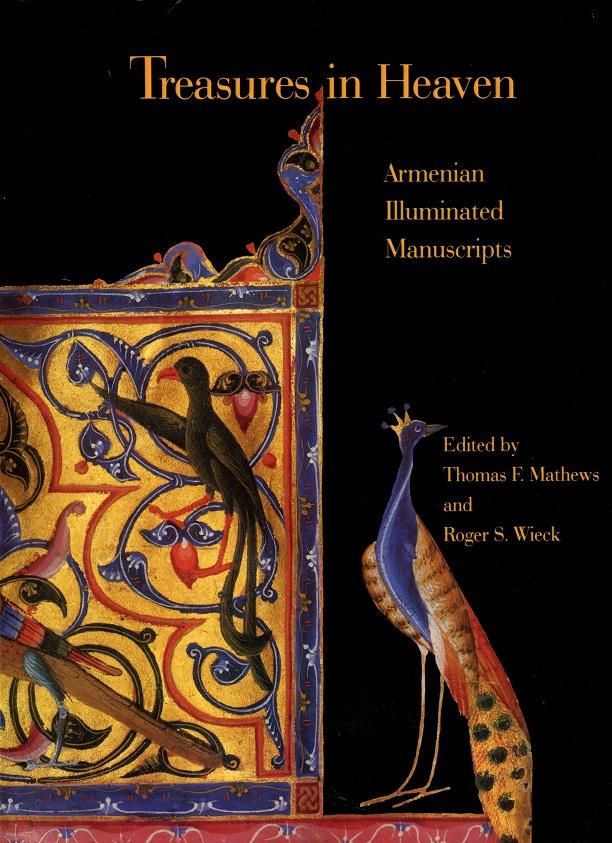 Rangement Beaux-livres
 | | Treasures in Heaven: Armenian Illuminated Manuscripts |
| Titre : | Treasures in Heaven: Armenian Illuminated Manuscripts / auteur(s) : Catalogues - Thomas F. MATHEWS - Edited by Thomas F. Mathews ans Roger S. Wieck |
|---|
| Editeur : | Princeton Univ Press |
|---|
| Année : | 1994 |
|---|
| Imprimeur/Fabricant : | Imprimeries réunies Lausanne |
|---|
| Description : | 23 x 30 cm, 296 pages, couverture illustrée en couleurs |
|---|
| Collection : | |
|---|
| Notes : | |
|---|
| Autres auteurs : | |
|---|
| Sujets : | Armenian manuscripts |
|---|
| ISBN : | 9780691037516 |
|---|
| Lecture On-line : | non disponible |
|---|
Commentaire :Preface by Thomas F. MathewsMount Ararat, robed in perpetual snow, is the tallest mountain in western Asia and the heart of ancient Armenia. Here flourished a people who can claim to be both the earliest nation converted to Christianity and the easternmost of all the kingdoms of medieval Christendom. The illuminated manuscript, and above all the Gospel Book, was their most important cultural artifact, revealing both their history and the strength of their native traditions. Although political independence often eluded them, and eventually invasions and deportations diminished Armenians' presence in their native homeland, their sense of national identity was always strong. Their illuminated manuscripts played a key role in preserving this cultural continuity, transmitting religious doctrine, historical records, and a blaze of brilliant images. Armenia made the art of the book into a vehicle of Armenian self-consciousness.
In the course of the past century a considerable number of these manuscripts have found their way to collections on this side of the Atlantic. Zealously guarded for centuries in Armenian church treasuries or hidden away as private family heirlooms, many manuscripts were finally dispersed in the mass murders and deportations of Armenians in 1895 and from 1915 to 1917. Whether confiscated by marauders, carried to new lands by emigres, or sold to raise hard cash, they soon appeared on the international art market. Wealthy American collectors, such as Henry Walters and J. R Morgan, Jr., gladly added them to their growing libraries of medieval manuscripts and curators readily accepted them in public museum collections. From a rare tenth-century Gospels made in Greater Armenia to books produced seven or eight centuries later among Armenians scattered around the Near East from Isfahan to Constantinople, they now constitute an artistic resource of incomparable value.
This publication is intended as an introduction to the art of Armenian manuscripts and a guide to eighty-eight of the most significant examples in North America. As an introduction to the field, it aims at filling a gap in existing literature by providing the general reader with an initial orientation to the subject as a whole. Our goal is to explain the principal accomplishments of Armenian illumination and to outline the chief problems involved in its study. We have been especially concerned to examine the religious purposes of manuscript illumination within the framework of the Armenian society to which it belonged. We recognize, too, that an understanding of Armenian illumination is impossible without considering its historical context.
The relationship of Armenian art to Byzantine art (as well as to Islamic and Western art) has frequently been discussed, but such studies often viewed the material chiefly from a stylistic point of view and defined Armenian art in terms of extrinsic influences. Armenian art, however, has a vocabulary of imagery somewhat distinct from other traditions of the medieval or post-medieval world, and it evolves through a stylistic sequence generated by the historical evolution of Armenia itself. We have tried, therefore, to describe Armenian art from the point of view of its internal dynamics. We want to look at the people for whom the manuscripts were made and the multiple purposes that they served, whether in the liturgy, as prestigious possessions, or as propaganda. The periods of Armenian art should be described from the Armenian point of view, conforming to the evolution of the Armenian people. Signs of dependence on outside traditions should be seen as symptoms of Armenia's changing relations with her neighbors. And the iconographic language of Armenian manuscripts should be interpreted as expressive of an Armenian way of understanding the Christian vision.
Approached in this way, Armenian manuscript illumination represents a national tradition that stands on its own. Drawing on ancient Christian sources, it transformed material that it assimilated from the pre-Christian cultures to construct a visual language capable of expressing an Armenian outlook and an Armenian experience. To achieve this, Armenian artists developed their own workshop traditions that they passed on from generation to generation. Whether in formulating programs of images, in mixing pigments, or in stitching the bindings, they developed their own way of manufacturing a book. All of these aspects we have tried to describe in this book.
The impact of Armenian art on the art of the world was small; Armenia was never a colonial power. To the student of art, however, the interest of these manuscripts lies both in their value for Armenian history and in the dimension they give to cul-tnral history. Byzantine art, for example, is in large part anonymous; few painters are known by name, and if their names are known generally nothing else is known about them. By contrast, the colophons and inscriptions of Armenian manuscripts supply names, dates, and places for hundreds of artists and scribes, along with copious information about the patrons who commissioned the manuscripts. This higher prominence of the individual parallels a higher premium put on personal initiative in painting. The receptiveness of Armenian painters to outside ideas and motifs is often noted, but the flip side of this coin is a freedom to experiment, to invent, to create. Not constricted by an all-encompassing tradition. Armenian artists often achieved results that would have been impossible among their more conservative neighbors.
The breadth of this subject, encompassing fields as diverse as history, religion, art, iconography, and chemistry has necessitated a collaborative effort. The authors of this collaboration are acknowledged American authorities in their respective areas. A chapter on Armenian history provides a general orientation to the structure of Armenian society and the changing picture of its relations with its neighbors. The following chapter treats the unique form Christianity took in Armenia and the place the book occupied in religious observance. Then, after a general introduction to the art of Armenian illumination, each major period is discussed in a separate chapter. The medieval kingdoms of Armenia, tiny though they were in geographical extent, attained a level of artistic culture in no way inferior to that of the great empires that overshadowed them on either side. In subsequent Armenian history the ancient arts were preserved and reshaped to speak to the needs of a minority community in a pluralistic society. A final chapter deals with the technical analysis of the manuscripts, the materials used in the paintings, and the craft of making the bindings. |
228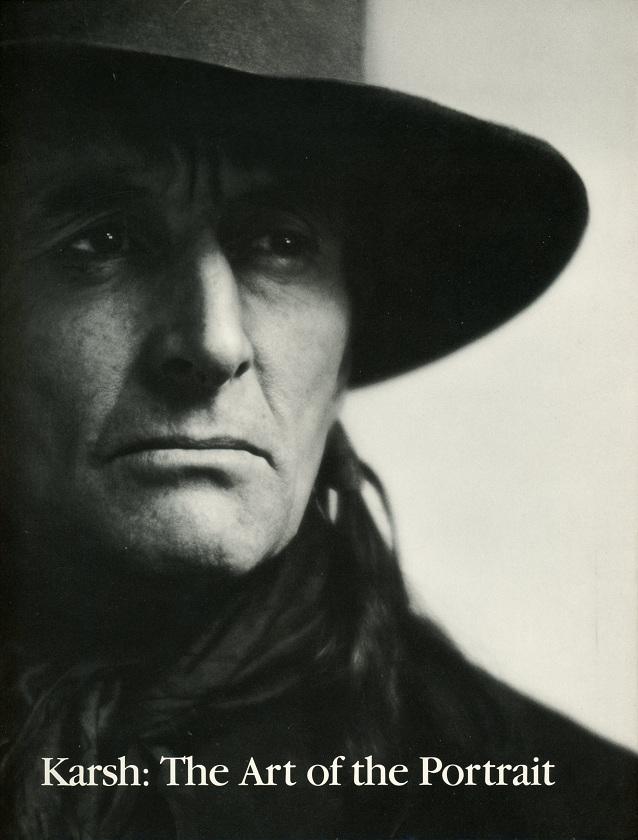 Rangement général
 | | Karsh : The art of the portrait |
| Titre : | Karsh : The art of the portrait / auteur(s) : Catalogues - Exhibition at the National Gallery of Canada, Ottawa |
|---|
| Editeur : | National Gallery of Canada, Ottawa |
|---|
| Année : | 1989 |
|---|
| Imprimeur/Fabricant : | M.O.M. Printing |
|---|
| Description : | 24 x 26 cm, 176 pages, couverture illustrée en noir et blanc |
|---|
| Collection : | |
|---|
| Notes : | |
|---|
| Autres auteurs : | |
|---|
| Sujets : | Kasrsh work |
|---|
| ISBN : | |
|---|
| Lecture On-line : | non disponible |
|---|
Commentaire :More than a hundred photographs, many never before published, glow richly from these pages in a major review of the art of internationally acclaimed portraitist Yousuf Karsh. Here, Churchill, Einstein, Georgia O'Keeffe, the Duchess of Windsor, join less famous subjects photographed over a career spanning almost sixty years. Essays by James Borcoman, Estelle Jussim, Philip Pocock, and Lilly Koltun offer the most extensive commentary to date on the work of this important Canadian artist.
Karsh was born in Armenia in 1908, and, after a difficult childhood, emigrated to Canada in 1924 at the age of sixteen. Now eighty, he is still an active photographer, and the recipient of numerous international honours and awards. In 1989, the one hundred and fiftieth anniversary of photography, Yousuf Karsh has made a generous gift of almost one hundred of his best-known photographs to the National Gallery of Canada. Approximately half of this gift, along with works from the collections of the artist, the Gallery, and the National Archives of Canada, comprise Karsh: The Art of the Portrait, the largest retrospective exhibition ever mounted of Karsh's oeuvre, presented and circulated by the National Gallery of Canada.
This volume offers readers new insights into the full range of the life and work of this internationally acclaimed Canadian photographer and portraitist. Following an exploration of the art of the Karsh photograph by James Borcoman, curator of the Karsh exhibition, art historian Estelle Jussim discusses the "psychological portrait" in the work of Karsh and his contemporaries, photographer Philip J. Pocock outlines the biographical, historical, and social context within which Karsh carried out his profession, and archivist Lilly Koltun describes the Karsh Collection, purchased by the National Archives of Canada in 1987 and comprising some 355,000 negatives, prints, and transparencies.
James Borcoman is the Curator, Photographs Collection, of the National Gallery of Canada, and organizer of the exhibition Karsh: The Art of the Portrait, on display at the Gallery and across Canada from 1989 to 1992. Estelle Jussim's award-winning books on visual art and photography include Slave to Beauty, a biography of F. Holland Day, and Visual Communication and the Graphic Arts. Philip J. Pocock's solo photography shows include The World Through One Eye, National Gallery of Canada; he is on the Advisory Council of the International Center of Photography, New York. Lilly Koltun is the Director of the Documentary Art and Photography Division of the National Archives of Canada, and curator of exhibitions including Private Realms of Light and City Blocks, City Spaces.
Combining insightful commentary with outstanding examples from every phase of Karsh's professional life, Karsh: The Art of the Portrait is a fitting tribute to almost six decades of achievement by the man who once said, "To make enduring photographs, one must learn to see with one's mind's eye, for the heart and the mind are the true lens of the camera." |
415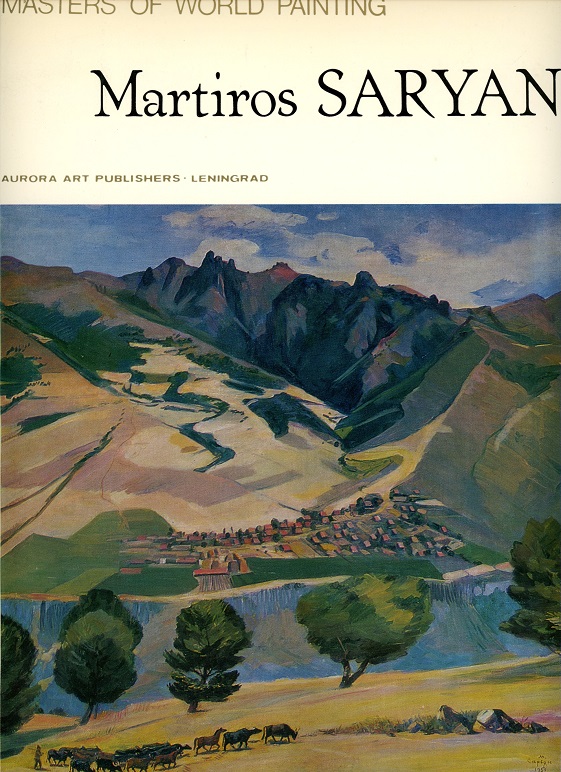 Rangement Beaux-livres
 | | Martiros SARYAN |
| Titre : | Martiros SARYAN / auteur(s) : Catalogues - |
|---|
| Editeur : | Aurora Art Publishers, Leningrad |
|---|
| Année : | 1985 |
|---|
| Imprimeur/Fabricant : | Printed and bound in the USSR |
|---|
| Description : | 14,5 x 32 cm, non paginé (textes et 40 planches couleur) |
|---|
| Collection : | Masters of world painting |
|---|
| Notes : | |
|---|
| Autres auteurs : | |
|---|
| Sujets : | Oeuvres de Martiros Saryan, conservées dans son musée ou au Musée des Beaux-Arts d'Erevan (Arménie) |
|---|
| ISBN : | |
|---|
| Lecture On-line : | non disponible |
|---|
Commentaire :There is nothing in the world I like more than the sun. All my life and work is bound up with it, for everything I have held dear, everything I have admired and enjoyed, everything I have painted and am to paint is due to the sun and its warmth. I am happy that in all the long years of my artistic career I have never been unfaithful to this idol of mine. To love it is to love the world, to love the earth and everything that inhabits it. Man, too, is this bright luminary's offspring and cannot but be loved. The artist is the happiest of mortals. He is endowed with the great gift of glorifying Nature and Man and should constantly remind humanity that Nature is kind and that it calls upon us to live in peace and accord. Martiros Saryan
|
401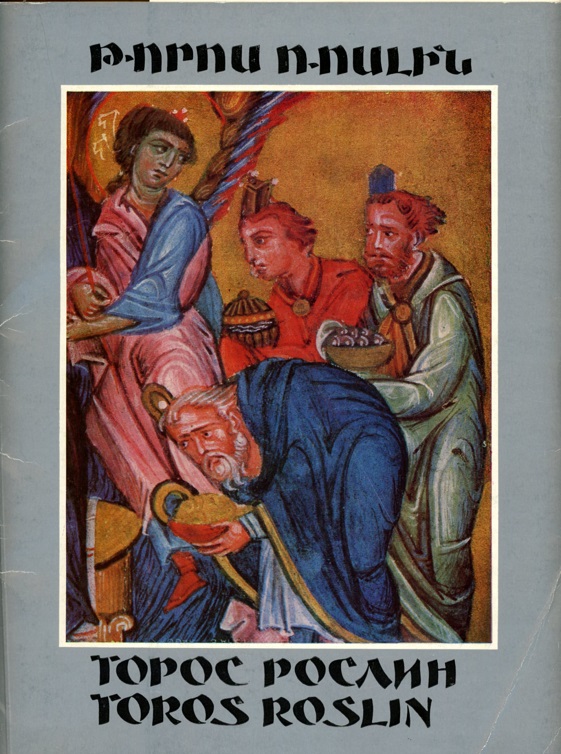 Rangement Beaux-livres
 | | Toros Roslin |
| Titre : | Toros Roslin / auteur(s) : Catalogues - |
|---|
| Editeur : | Sovetakan Grogh |
|---|
| Année : | 1985 |
|---|
| Imprimeur/Fabricant : | Erevan |
|---|
| Description : | 22,5 x 29 cm, non paginé, 25 planches illustrées en couleurs sous cartonnage |
|---|
| Collection : | |
|---|
| Notes : | Sur la couverture, l'Ange et les trois mages (fragment de la miniature de l'Adoration des Mages), Peintre Toros Roslin 1267-1268 |
|---|
| Autres auteurs : | |
|---|
| Sujets : | Enluminures de Toros Roslin |
|---|
| ISBN : | |
|---|
| Lecture On-line : | non disponible |
|---|
Commentaire : |
458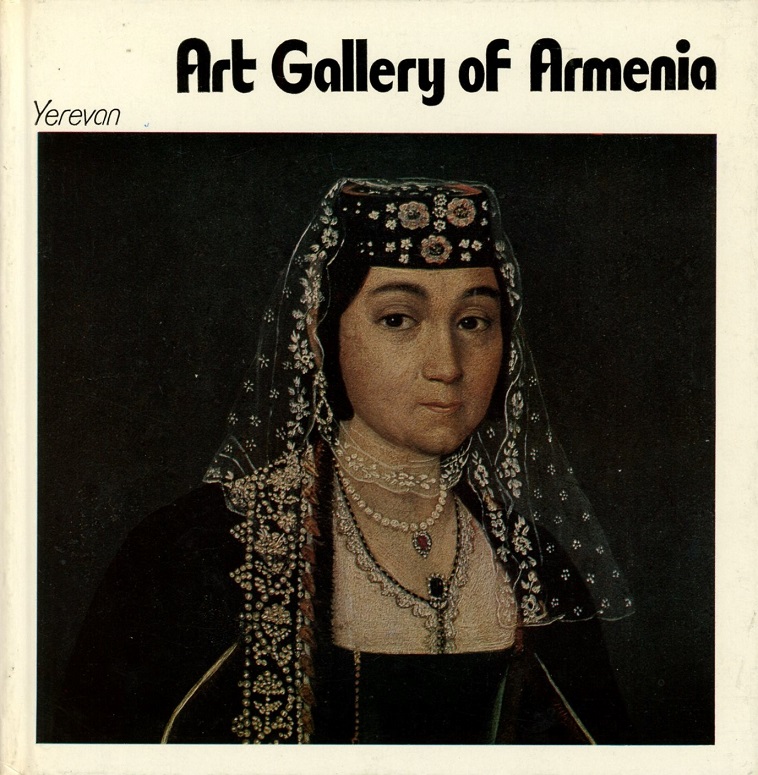 Rangement général
 | | Art Gallery of Armenia, Yerevan |
| Titre : | Art Gallery of Armenia, Yerevan / auteur(s) : Catalogues - |
|---|
| Editeur : | Aurora Art Publishers, Leningrad |
|---|
| Année : | 1984 |
|---|
| Imprimeur/Fabricant : | Aurora Art Publishers, Leningrad |
|---|
| Description : | 18 x 16 cm, 160 pages, couverture illustrée en couleurs |
|---|
| Collection : | |
|---|
| Notes : | |
|---|
| Autres auteurs : | |
|---|
| Sujets : | |
|---|
| ISBN : | |
|---|
| Lecture On-line : | non disponible |
|---|
Commentaire : |
405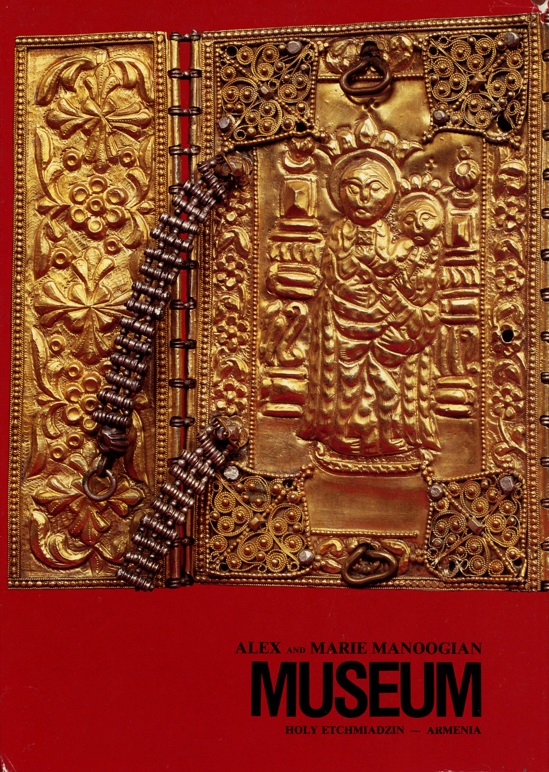 Rangement Beaux-livres
 | | Alex and Marie Manoogian Museum |
| Titre : | Alex and Marie Manoogian Museum / auteur(s) : Catalogues - Holy Etchmiadzin - Armenia |
|---|
| Editeur : | Erebouni |
|---|
| Année : | 1984 |
|---|
| Imprimeur/Fabricant : | YKP, Finland |
|---|
| Description : | 21,5 x 30 cm, non paginé, couverture illustrée en couleurs |
|---|
| Collection : | |
|---|
| Notes : | |
|---|
| Autres auteurs : | |
|---|
| Sujets : | Catalogue d'un musée inauguré à Etchmiadzine le 11 octobre 1982 |
|---|
| ISBN : | |
|---|
| Lecture On-line : | non disponible |
|---|
Commentaire :From time immemorial the Armenian people have created cultural artifacts of lasting value cm-bodying popular artistic concepts. These objects reveal the innate talents of anonymous masters, as well as their sense of beauty. This cultural heritage is anchored on a coherent national base, and the functional value of the objects themselves is always integrated with the esthetic philosophy of the people.
Since ancient times, Armenian artifacts have been created, not only in Armenia itself, but also in many other parts of the world. Arts and crafts have always occupied a prominent place in Armenian life. Wars, deportations, the collapse of various Armenian states frequently disrupted the development of Armenian arts and crafts. Despite such reversals, under new conditions and often in new locations, Armenian artists and artisans continued to create works endowed with new qualities and shapes, which nevertheless were based on principles of the traditional national art.
At different periods in history, cities such as Ani (the bustling capital of medieval Armenia), Dvin (the "grand capital"), the cities of the Cilician Kingdom and Vaspurakan. Garin. Erzinga. Sebastia. Gesaria (Caesaria). Kcmakh. Evtogia, Marash. Aintab, Madras, New Julfa. Constantinople and others within Anatolia were centers of Armenian craft production. The creations of Armenian artisans found their way into European and Eastern markets via the great trade routes. The ornamental use of these articles in royal courts set standards of beauty and became a mark of wealth.
Throughout the centuries, visitors and pilgrims to Holy Etchmiadzin who sought the salvation of their souls, or to commemorate loved ones, donated beautiful, appropriately inscribed artifacts to the Mother See. Numerous such objects arrived at Holy Etchmiadzin during deportations and massacres. After finding refuge at the monastery, many of the exiles delivered to the Holy See relics rescued at the expense of their untold sufferings.
The collection of art objects at the Mother See has also been enriched through donations received by the various Catholicoses and other members of the Brotherhood. Acquired over the centuries, these objects are preserved in the old and new Catholical residential buildings and in the museum of the Mother Cathedral.
Recently, a new museum known as the Alex and Marie Manoogian Treasury has been added to the aforementioned; it was officially dedicated on October II. 1982. The Manoogian Treasury occupies a very special place among museums that display Armenian artifacts. The Treasury building (B. Arzumanian. architect), with its colonnaded hall and portico, blends in with the architectural style of the rest of the complex, and especially with the new Catholical palace. It is specially designed as a museum structure, and is equipped with a unique lighting system and spacious galleries.
Displayed there are representative examples of Armenian art objects, paintings, manuscripts and ancient coins. Prominent among these are religious objects such as gold and silver-encased relics, chalices, crosses, staffs, fans, reliquaries, communion pyxes, censers, processional banners, carpets, embroidered drapes and vestments. All these have esthetically significant designs and express specific features of Armenian national culture.
Reliquaries are presented in the established classical forms. The most prominent among these is the "Holy Cross of Khotakerats" commissioned by Prince Eatchi Proshian in the year 1300, which is significant not only because of its age but also for its artistic embellishments and delicate engravings. Equally delicate decorations are found on the chalices and the reliquaries which are sometimes studded with precious gems. Gems add a unique richness to the art on crosses, manuscript covers and staffs. All of these were created in centers of the Armenian goldsmith's art, such as Sis, Adana, Vaspurakan (especially Van and Ardzgh), Constantinople, Smyrna, Garin. Gesaria, Yerevan, Tiflis and New Julfa. The Garin tradition was later carried on by the masters who moved to Akhaltzkha (presently in Soviet Georgia) during the nineteenth century. Armenian goldsmiths were masters of the techniques of engraving, shaping, meshing, threading and granulation. Belt buckles made at the same centers are predominantly in silver, sometimes gilded and adorned with pearls.
Armenian, Greek, Roman. Parthian, Iranian, Byzantine, and other gold, silver and copper ancient coins, exhibited of the first floor of the museum, testify to the wide scope of international ties maintained by the Mother See throughout history.
Among the most beautiful artifacts displayed are the embroideries. These consist basically of delicate and exquisite patterns, peculiar to the art of Armenian needlework.
The religious vestments, such as chasubles, palliums, stoles, mitres, infulae, amices and cuffs, have embroideries depicting dominical scenes -such as the pictures of the Mother of God, Christ, the evangelists, the apostles and saints. The judicious selection of colorful threads, the gold and silver additions, the hues of precious and semiprecious gems, and the strings of beautiful pearls elevate these works to the level of true art. The inscriptions embroidered upon them indicate that they were crafted both in Armenia and the Armenian communities of the Diaspora (such as Marash, Aintab, Sunik, Cilicia, Cappadocia, Astrakhan, Constantinople, and others).
The processional banner of St. Gregory the Illuminator, dating from 1448, is prominently displayed in the Treasury, and is a masterpiece of Armenian embroidery. The banner, which depicts the first Catholicos, as well as King Trdat, and St. Hripsime, is an exquisite sample of creative portraiture.
Among the woven artifacts, the curtains are especially noteworthy. Prominent among them is a main-altar curtain designed by Grigor Marzvanetsi, the famous publisher-painter from Constantinople. Begun in 1705 and completed in 1714, this is one of the important decorative items of the Treasury. The so-called "eagle rugs" are of great artistic value. A salient example of this category is the embroidered eagle rug of Catholicos Philipos (1751).
Each of these art objects has its specific style, embellishments and canonical form, developed over the centuries. Yet the crosses on chasubles, the portraits of evangelists embroidered on palliums, the dominical scenes on mitres are also the results of the unique artistic talents and vivid imagination of the creative masters. Embroideries executed by anonymous talents in convents and orphanages are also represented among the artifacts in the Treasury. The superb samples of imprinted curtains are of special value. World-renowned Armenian rugs and runners of Karabagh, woven during the eighteenth century, are also displayed.
Armenian miniature art attained its glorious culmination during the sixteenth century; thereafter it was replaced by the new art forms, particularly painting, which developed under European influences. The Treasury also features a valuable collection of illuminated manuscripts, bearing popular and classical motifs, originating from different periods and regions.
The Holy See of Etchmiadzin has sponsored Armenian artists throughout the centuries. Naghash Hovnatan; his sons Hakob and Harutune: his grandson Hovnatan Hovnatanian: the latter's son Mkrtum and grandson Hakob were among these artists, as were many other anonymous masters. Hovnatan Hovnatanian (1730-1801) distinguished himself by remodeling and embellishing the Cathedral of Etchmiadzin (1765-1786). His portraits of historic figures and his thematic paintings add a special luster to the Treasury. Hovnatan Hovnatanian founded yet another distinctive artistic tradition in Armenia.
Thanks to the patriotism and generosity of Alex and Marie Manoogian, the cultural undertakings of His Holiness Vazgen I have been brought to fruition, and Armenia has been enriched with one more institution, the Alex and Marie Manoogian Museum, where the treasures created by our talented ancestors will be preserved for posterity.
Prof. MANIA KHAZARYAN Director
Department of Arts
Academya of sciences
Armenian SSR |
215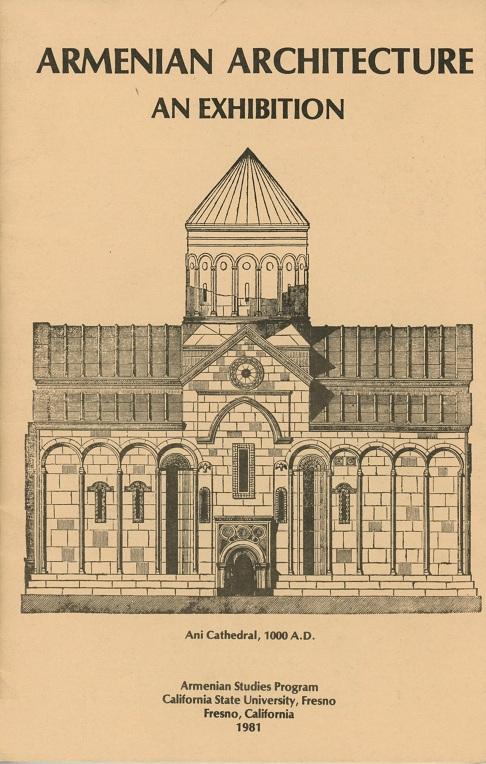 Rangement général
 | | Armenian architecture, An exhibition |
| Titre : | Armenian architecture, An exhibition / auteur(s) : Catalogues - |
|---|
| Editeur : | Armenian Studies program, California State University, Fresno |
|---|
| Année : | 1981 |
|---|
| Imprimeur/Fabricant : | |
|---|
| Description : | 14 x 22 cm, 16 pages, couverture illustrée en noir et blanc |
|---|
| Collection : | |
|---|
| Notes : | |
|---|
| Autres auteurs : | |
|---|
| Sujets : | Armenian architecture |
|---|
| ISBN : | |
|---|
| Lecture On-line : | non disponible |
|---|
Commentaire :A vast exhibit of Armenian architecture from the 4th to 18th century will be shown at the Phebe Conley Art Gallery on the California State University, Fresno campus from October 4th to 28th, 1981. The exhibition was conceived and prepared by a team of Italian and Armenian architectural historians in Milan, Italy. It has been acclaimed throughout the world as a model of its kind, bringing to a western public a comprehensive view of the church architecture of an eastern Christian people, the first to accept Christianity as a state religion in the early 4th century.
The exhibit has already been shown in various cities in France, Belgium, Portugal, Austria, Germany, Lebanon, Iran, Argentina, and most major cities of Italy. A joint effort of several university programs of Armenian studies, including Columbia, Harvard, Michigan, UCLA and Fresno State has finally brought thjs^remarkable show to the United States.
Armenian architecture has long been recognized as the first church architecture to reflect a unique style, having perfected its various and complex forms already by the 7th century. Until recently, there were few books and no major exhibitions for scholars and the general public to study the monuments, for the most part of difficult or impossible access. At the initiative of a group of specialists at the Milan Polytechnic, spearheaded by Adriano Alpago-Novello and supported by the Armenian Cultural Union of Italy and especially the Manoukian and Pambakian families of Milan, an enormous photographic exhibit was assembled based on materials collected during several expeditions into Turkish occupied Armenia, Iran, and the Soviet Armenian Republic; the work was assisted by the Armenian Academy of Sciences. Nearly 70 masterpieces of early Armenian church architecture, including monastic complexes, are presented through a series of floor plans and elevations, exterior and interior photographs, and numerous sculptural details. Precise explanations accompanying each of the monuments provide the historical, structural, and artistic background for each building.
The exhibit has been praised by both experts and the general public wherever it has appeared. It unveils the mystery behind the powerful and creative building genius of this remote Christian people. The various elements of the display allow the viewer to appreciate the mastery of masons who came from a stone-carving tradition thousands of years old. Some specialists even see in the various masons' marks carved on these buildings, the beginnings of the mason guilds and ultimately the masonic movements in medieval Europe.
(…)
Dickran Kouymjian |
216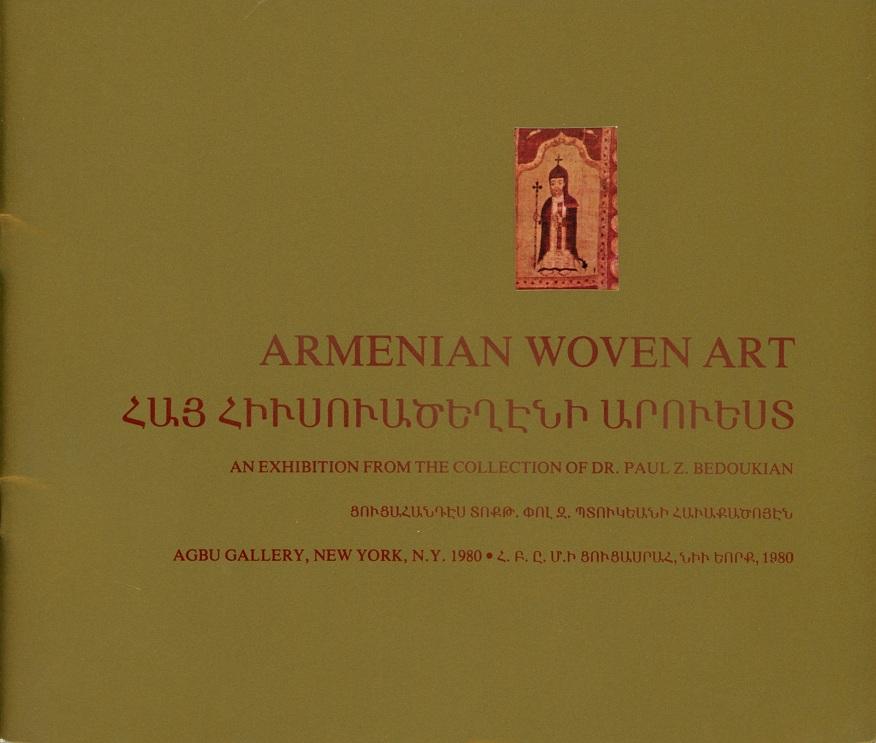 Rangement général
 | | Armenian woven art |
| Titre : | Armenian woven art / auteur(s) : Catalogues - An exhibition from the collection of Dr. Paul Z. Bedoukian |
|---|
| Editeur : | agbu |
|---|
| Année : | 1980 |
|---|
| Imprimeur/Fabricant : | Manne Takoushian of Lordian Press |
|---|
| Description : | 22 x 18 cm, 28 pages, couverture illustrée en couleurs |
|---|
| Collection : | |
|---|
| Notes : | |
|---|
| Autres auteurs : | |
|---|
| Sujets : | Armenian art |
|---|
| ISBN : | |
|---|
| Lecture On-line : | non disponible |
|---|
Commentaire :Text for the Altar curtainIn common with all ancient Christian churches, the Armenian church has an altar which at times is concealed from the parishioners by a curtain. The curtains in the larger churches or cathedrals were embroidered works of art, made with much care and expense. The village churches generally had to make do with curtains of more modest design.
Since altar curtains were in constant use, they had to be replaced periodically and it was important to obtain new ones quickly and economically. The answer appears to have been the printed cloth which was within the means of most churches.
The art of preparing such curtains has not been studied, but a number of them have been mentioned in the literature on Armenian woven art. As expected, all relate to Biblical episodes.
The interesting curtain on exhibit presents many points requiring clarification. It seems to portray a mixture of Biblical scenes as well as Moslem or Persian figures. Its styling and fabric suggests that it was made in the seventeenth or eighteenth century. |
403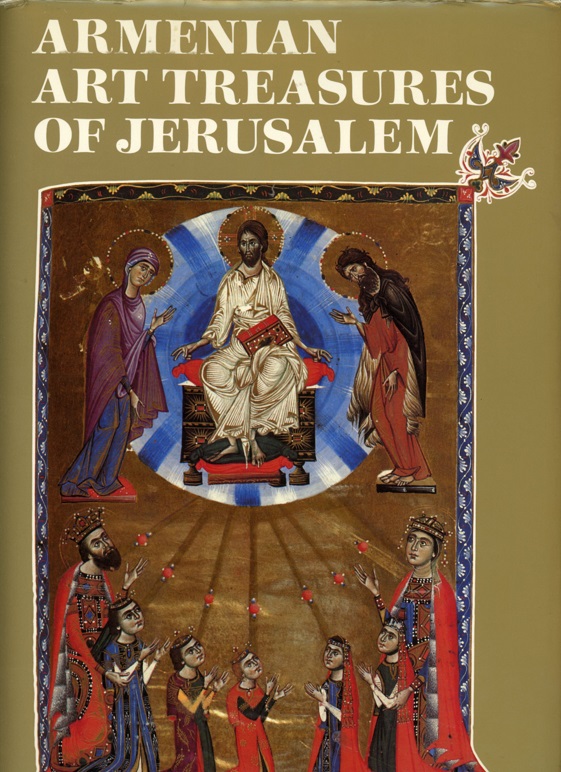 Rangement Beaux-livres
 | | Armenian Art Treasures of Jerusalem |
| Titre : | Armenian Art Treasures of Jerusalem / auteur(s) : Catalogues - Bezalel Narkiss, in collaboration with Michael E. Stone |
|---|
| Editeur : | |
|---|
| Année : | 1979 |
|---|
| Imprimeur/Fabricant : | De Lang/Van Leer-Deventer, The Netherlands |
|---|
| Description : | 24 x 33 cm, 174 pages, jaquette illustrée en couleurs |
|---|
| Collection : | |
|---|
| Notes : | Historical survey by Avedis K. Sanjian, Letter by His Beatitude Elisha II,the Armenian Patriarch of Jerusalem |
|---|
| Autres auteurs : | |
|---|
| Sujets : | Armenian art, Jerusalem |
|---|
| ISBN : | |
|---|
| Lecture On-line : | non disponible |
|---|
Commentaire :One of the world's greatest art treasures is here brought before the wide public for the first time. It is the collection of the Jerusalem Patriarchate of the Armenian Church, which is the richest and most important concentration of Armenian art in the world. Its wealth stems from the place of Jerusalem, the Holy City, in the minds and hearts of the Armenians throughout their existence as a Christian nation - since the fourth century A.D. Pilgrims brought to Jerusalem many of the outstanding creations of Armenian artists, which were deposited in the treasury and library of the Armenian Cathedral of St. James.
Hitherto the knowledge of this collection has been confined to a limited circle. Now, for the first time, it has been photographed and described on an extensive scale. This volume unveils a dazzling variety of art objects - sumptuous medieval illuminated manuscripts, printed books, mosaic pavements, painted tiles and ritual objects.
The book contains 194 illustrations, of which 131 are in color. A full description of the Armenian art treasures of Jerusalem and their background has been written by Professor Bezalel Narkiss, head of the Department of Art at the Hebrew University, Jerusalem. His collaborator, Professor Michael E.Stone, of the Department of Armenian Studies of the same University, has contributed a detailed catalogue of the objects illustrated. An introductory chapter on the history of the Armenian Communities in Jerusalem has been written by Avedis K. Sanjian, Professor of Armenian Studies at the University of California, Los Angeles. |
39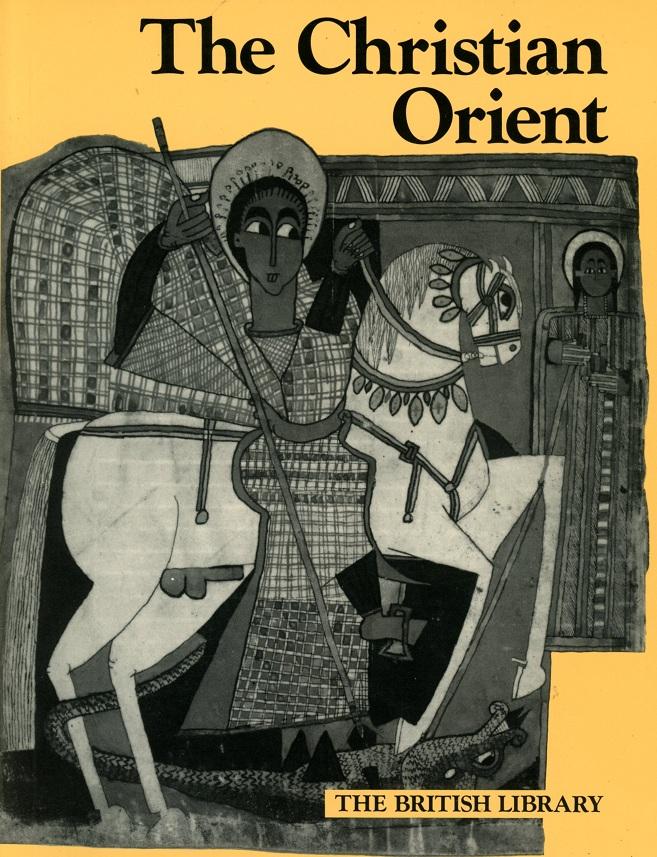 Rangement général
 | | The Christian Orient |
| Titre : | The Christian Orient / auteur(s) : Catalogues - |
|---|
| Editeur : | The British Library |
|---|
| Année : | 1978 |
|---|
| Imprimeur/Fabricant : | G E Pindat, Scarborough |
|---|
| Description : | 19 x 24,5 cm, 80 pages, 32 photographies hors-texte |
|---|
| Collection : | |
|---|
| Notes : | |
|---|
| Autres auteurs : | |
|---|
| Sujets : | Exhibition in the King's Library in the British Library from July to September 1978 |
|---|
| ISBN : | 0714106666 |
|---|
| Lecture On-line : | non disponible |
|---|
Commentaire :The Christian Orient is a term which has been widely accepted as referring to the ancient Churches of the Middle East who have preserved their traditions of worship and fellowship, literature, architecture and art from the earliest times until the present day, even where the lands in which they dwell have been dominated by other civilizations in the course of the centuries.
A matter of key interest is the relationship between the Orthodox tradition and that of other Oriental Christians where there were important mutual influences despite some doctrinal differences. This can be seen when manuscripts representing the Greek tradition, including examples from Constantinople and the other Greek centres, Slav Churches and the Georgian are set side by side with scriptures, liturgies and other texts in Syriac, representing both the Jacobite and Nestorian traditions, Christian Arabic, Coptic, Nubian, Ethiopic and Armenian. The British Library collections are rich in the literatures of many of these Churches and include some splendidly illuminated manuscripts among them. These have been supplemented here by fine examples from the collections of the Bodleian Library, Oxford, and the Chester Beatty Library, Dublin, as well as by a selection of objects relating to Christian life and worship from the British Museum.
The interest we believe that this survey will elicit is first the recognition of many familiar artistic themes, including Old Testament scenes, episodes from the life of Christ and of the Blessed Virgin Mary, portraits of the Evangelists and scenes from the lives of the Saints, in styles different from the tradition of Western Europe; secondly, a comparison among the artistic styles of the various Churches represented. We have not tried to suggest the exact relation of mutual influence between Byzantine painting and that of the other Eastern Churches. Undoubtedly these influences did not all flow in one direction, but the evidence of the items themselves will show the closeness of their development which persisted over the centuries even when there were critical theological differences among the various communions.
Hugo Buchtal and Otto Kurz, the authors of the Handlist of Illuminated Oriental Christian Manuscripts alluded to this question at the outset of their work:
'The outstanding problem which concerned other historians of Byzantine art is that of the persistency of the Hellenistic tradition on the one hand and the influence of Near Eastern non-Greek art in Christian painting on the other. The classical tendency in Byzantine art is generally described as the survival of late Hellenism; the Oriental influence is regarded as being due to the art of early Christian Syria, Armenia and Egypt. But whereas the architecture of Eastern Christianity has been thoroughly studied, research on the subject of illumination of manuscripts written in the national languages of the Eastern Churches outside Europe has generally been confined to very few examples'.
A good number of the manuscripts referred to by Buchtal and Kurz have been included here and although we would ourselves not offer a solution to the problem of their research, the examples now shown should help in that study. They, however, brought their discussion down only to the fall of Constantinople in 1453 and omitted reference to later materials where the artistic traditions continued in the various Churches but often with new developments, and these too are represented here.
The illuminated manuscript, however, was not an end in itself, but rather a product of the piety and artistic inspiration of a believing community; it served as an adjunct to the holy texts which in their turn had their proper use in the conduct of Christian worship. It is a fact that most of the literatures here represented were very largely Christian in content. Theological writings were wide ranging, but at the centre of all were the scriptures, liturgies, prayer books, hymn books and lives of the Saints. It was these which were needed by ruler and people, by bishop, priest, monk and layman alike for their devotions and it was these which were accorded special attention in the beauty of the scripts in which they were written and in the decoration and illumination which often accompanied them.
The inheritance, both literary and artistic, was a complex one in which the Jewish and wider Semitic background of primitive Christianity played a key part. Equally, the inheritance of the Hellenistic world, including the art and learning of that tradition promoted both in Egypt and Syria, made its contribution. We note here that one of the effects of St Paul's missionary labours was to bring the Jewish and Hellenistic elements of current civilizations together and provide a basis upon which the new Christian culture could develop.
The two most ancient patriarchates of the East were Antioch and Alexandria, both centres of Hellenistic culture, but representing different emphases in their view of the world and consequently of their synthesis of Christian doctrine. These were later to issue in the great Christological controversies of the fourth and fifth centuries AD. In the meanwhile, at the beginning of the fourth century Jerusalem acquired a new importance with the visit of St Helena, mother of Constantine, in AD 326 to venerate the holy places. Shortly afterwards Constantinople became the capital of the Empire and by the middle of the fifth century its Bishop had acquired patriarchal dignity, but not without controversy with the earlier Eastern Churches. Meanwhile the Armenians were the first nation to adopt Christianity officially at the beginning of the fourth century, and the Georgians were evangelised by St Nino slightly later.
Among the early Councils of the Church the most critical for the later history of Eastern Christianity were those of Ephesus, held in 431, at which Nestorianism was condemned and from which time the distinctive character of Eastern Syriac Christianity can be said to have been established. At the Council of Chalcedon (just across the Bosphorus from Constantinople) in 451 the Monophysites, or those who believed in the one nature of Christ, were condemned, the jurisdiction of Constantinople was asserted and the division of Christendom into five Patriarchates was made: Rome, Constantinople, Alexandria, Antioch and Jerusalem. This breach between the Orthodox and Monophysite Churches, although it was strongly defended on theological grounds on both sides, was greatly reinforced by the political rivalries of the various centres concerned. It is from this time that the more distinctively national characteristics became apparent. The Copts in Egypt and the Ethiopians who were closely related with them, both adopted the Monophysite doctrine, as did the Western Syrians, later to be known as Jacobites. The Armenians, busy fighting the Persians, had not been represented at Chalcedon and never recognised its authority, though they do not claim so unambiguously to be bound by the Monophysite position. The Georgians also broke their relationship with Byzantium after Chalcedon, but resumed it in 607 and became an autocephalous Orthodox Church, as were the later Slav Churches.
The later development of Byzantium and the Orthodox Churches is discussed in Chapter 2. For them, as for the Oriental Churches, the rise of Islam was one of the cataclysmic experiences in their later history. The Prophet Muhammed began his preaching in Mecca about AD 610 and from then until his death in 632 consolidated his position in Arabia, the base of subsequent theocratic imperial expansion from which the Christian countries of the Middle East were overrun by 641. In subsequent centuries the Christian Churches of the region maintained their existence, but precariously as tolerated minorities within the Islamic dominions. It became the policy of the Caliphate to recognise the heads of the various Churches as the civil leaders of their communities for whom they were answerable to the Islamic powers. Christian polity was engaged in maintenance of the faith and integrity of the community in these restrictive conditions, and this situation shaped much of their subsequent psychology and history.
The western view of Islam in the ancient centres of Christianity was a very different one, of confrontation rather than adaptation, and resulted in the Crusades from the end of the eleventh to the end of the thirteenth centuries, which finally failed in their objective of freeing the holy places, but also were a major factor in the estrangement between Eastern and Western Christians. The final critical fact in this story was the fall of Constantinople to the Turks in 1453.
For all the diversity of history and temperament which characterises the Churches of the East, there is some degree of common tradition which is seen in their style of teaching, worship and artistic expression, which also differentiate them from the developments in Western Christianity. There are, naturally, aspects of divergence in architectural style among the Oriental Churches, but in the liturgy and its physical, musical and artistic setting there are many points of resemblance in the practice of the Churches even when far apart geographically or of different theological allegiances.
The Icon, which characterizes Eastern Christianity and developed out of the compromise solution following the Iconoclastic controversy of the eighth and ninth centuries, is a shared tradition in these Churches and closely relates to the development of manuscript illumination.
Similarly, the form taken by the book in the service of the Churches, whether scriptures, liturgies, prayers or lives of the Saints, is one in which there are many points of common development throughout the region - the successive use of papyrus, parchment and paper; the development of the Codex as the standard form; advances in leather bookbinding, in which the Coptic tradition in Egypt was preeminent in the production of fine tooled bindings - all these reveal parallels from the various sources. Even more important comparisons can be made of the manner in which these books were decorated: there are the Canon Tables, with their characteristic arcaded frameworks; the portraits of the Evangelists which precede the Gospels; the decorated headings which begin the various books of the Bible; ornate initials, illustrations in the margins of texts, and full page miniatures illustrating the Life of Christ, and of his Mother and the Saints, and other similar themes.
Moreover, it is not only in the choice of subject matter, but in the details of presentation that the similarities are to be found. The exact affinities have in many cases still to be determined, as also the direction in which the influences travelled -probably both ways - but the items here described well illustrate the complexity and fascination of this aspect of the subject.
What, however, comes out equally strongly is the overall unity of purpose and even of interpretation, and a considerable consensus as to what is important to represent artistically of the Christian message, which may perhaps best be summed up in the words of St Vincent of Lerins:
Quod ubique, quod semper, quod ab omnibus creditum est.: What has been believed everywhere, always, and by all. |
441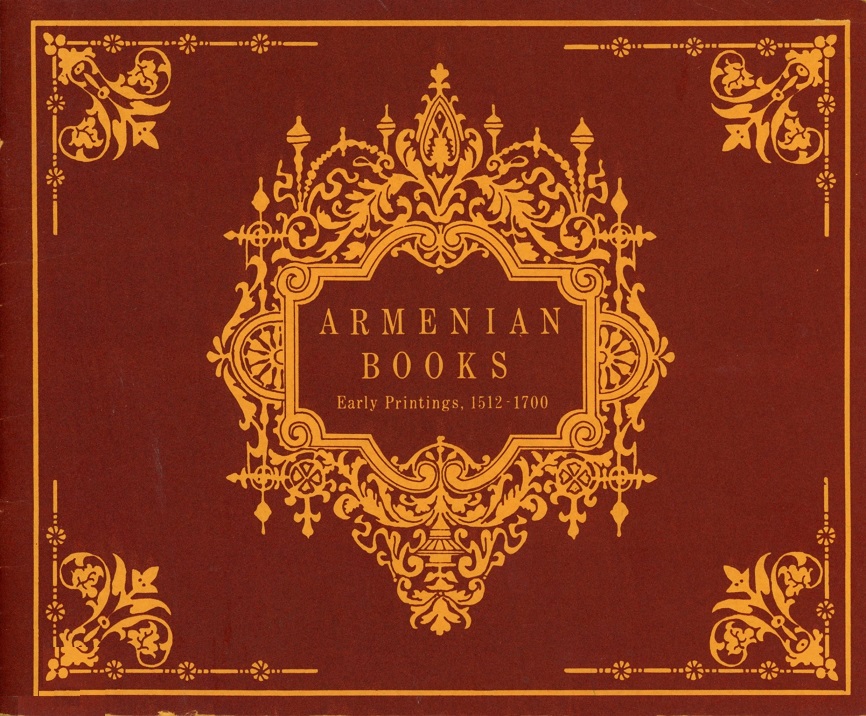 Rangement général
 | | Armenian Books - Early Printings 1512-1700 |
| Titre : | Armenian Books - Early Printings 1512-1700 / auteur(s) : Catalogues - From the collection of Dr. Paul Z. Bedoukian |
|---|
| Editeur : | Armenian Museum - Diocese of the Armenian Church of America |
|---|
| Année : | 1975 |
|---|
| Imprimeur/Fabricant : | New York |
|---|
| Description : | 21 x 5 x 17,5 cm, 24 pages, couverture illustrée, nombreuses reproductions en NB |
|---|
| Collection : | |
|---|
| Notes : | Exhibition design by Dikran Dingilian and Torkom Demirjian ; Catalog prepared by Paul and Victoria Bedoukian |
|---|
| Autres auteurs : | |
|---|
| Sujets : | Catalog - Exhibition of Armenian early printings |
|---|
| ISBN : | |
|---|
| Lecture On-line : | non disponible |
|---|
Commentaire :Rich in cultural heritage but destined for long periods to live under the yoke of barbarian peoples, the Armenians were forced to carry out cultural activities outside their homeland. It is indeed to their credit that under such circumstances, scarcely sixty years after the invention of Gutenberg's printing press, they were able to print their first set of books in Venice in 1512-1513. They thus placed themselves ahead of most European countries in that they had printed books in their own language. Of the fifteen Republics in the Soviet Union, Armenia has the earliest printed book. In the years 1512-1513, Hagop Meghabard travelled to Venice and published five titles. One of these is on exhibition. Italy continued to be the center of the publishing business and subsequently many Armenian books, mostly religious in nature, were printed in Venice, Rome, Milan, Livorno, and Padua. Eventually, Italy served as the center of Armenian renaissance with the establishment of the Mekhitarist order in Venice in 1701. One of the earliest Armenian printers, Abkar Tebir, printed some books in Italy and then took his letter types to Constantinople where he produced six books from 1567 to 1569. Thereafter, books were printed in Constantinople whenever the Sultan permitted. It might also be mentioned that printing in the Turkish language was initiated by Armenians. In the seventeenth century, printing in Armenian took place in Poland, France, Persia, Germany, etc., but it really flourished in Holland where the relatively free political atmosphere permitted publication of books not subject to the strict censorship of the Catholic Church. It was in Amsterdam that Oskan Erevantsi published the first complete Armenian Bible in 1666. Examples of this Bible are on exhibition. Although printing in Armenian is now carried out in many countries, for the first time in centuries Armenia is able to carry out printing in its own country and language. The great majority of Armenian books appearing today are printed in Soviet Armenia. |
238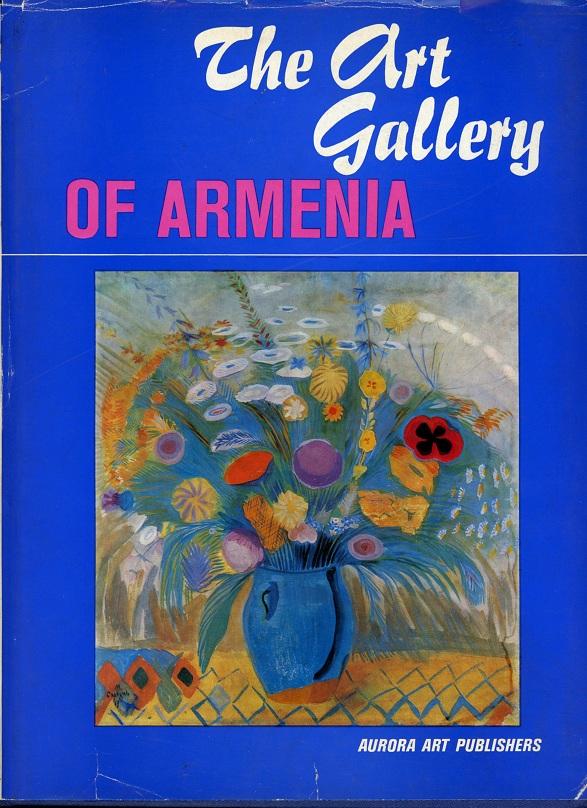 Rangement Beaux-livres
 | | The art gallery of Armenia |
| Titre : | The art gallery of Armenia / auteur(s) : Catalogues - |
|---|
| Editeur : | Aurora art Publishers, Leningrad |
|---|
| Année : | 1975 |
|---|
| Imprimeur/Fabricant : | |
|---|
| Description : | 22,5 x 30 cm, 180 pages, couverture illustrée en couleurs |
|---|
| Collection : | |
|---|
| Notes : | Introduction by N. Mazmanian |
|---|
| Autres auteurs : | |
|---|
| Sujets : | Art Galley of Armenia |
|---|
| ISBN : | |
|---|
| Lecture On-line : | non disponible |
|---|
Commentaire :In the course of their age-long history the people of Armenia made superb contributions to all forms of visual art. Before the October Revolution works of Armenian artists had been the property of private collectors and monasteries. It was only after the Revolution, at the beginning of 1921, that, following a governmental decree, the State Museum of Armenia was founded. The Museum incorporated several departments, including a department of art whose nucleus was formed by a limited number of canvases purchased from an exhibition sponsored by the Society of Armenian Artists in Erivani. In 1924 the Museum benefited considerably by the transfer to it of a modest but valuable collection from the former Lazarev Institute of Oriental Languages in Moscow, the bulk of which consisted of portraits. Among these were works by such outstanding masters of Russian painting as D. Levitsky and V. Tropinin, as well as some sculptures by I. Martos and others. A truly significant acquisition was a collection of paintings and graphic works from the Matenadaran (a repository of books) in Echmiadzin. Subsequent additions came from the Hermitage, the Russian Museum and the State Museum Reserve. By 1935 the Department of Art had so substantially expanded that it was transformed into a separate museum of fine arts, known since 1947 as the Art Gallery of Armenia. The augmentation and completion of the Gallery's holdings proceeded along different lines; part of the collection, for instance, was acquired on the annual grants allotted by the government of the Republic.
Many works came as gifts from Soviet and foreign Armenian artists, collectors, societies and committees. A large number of their own works were presented to the Gallery by Edgar Shain and Garzou of France. The canvases of V. Sureniants and some nineteenth century Russian painters, notably Ivan Aivazovsky, came from Ja. Ekizlere, an engineer, while the paintings of N. Lancret, Th. Rousseau, N. Diaz de la Pena, A. Monticelli, E. Boudin and L. Anquetin were donated by Zambakhchian, a Rumanian art historian. The Portrait of M. Akimova, one of the finest works by V. Serov, was presented by V. Kana-nian, the mother of the artist's model.
Further additions consisted mainly of works bequeathed to the Gallery by various artists. More than a thousand paintings, drawings and sketches from the collection of F. Terlemezian were transferred to the Gallery in accordance with lists he had compiled as early as the 1930s in the United States of America. Fhe most noteworthy canvases from the collection of E. Tatevosian were received from his widow.
Somewhat later the Gallery was enriched by the sculptures of A. Ghiurjian. The gem of these multifarious art treasures is the collection of paintings concentrated in the Departments of Armenian, Russian and Western European Art.
The Gallery's fullest and most comprehensive department is that of Armenian painting. The exhibition of the department opens with copies of sixth century frescoes and embraces all the characteristic trends of development of Armenian visual arts from the dawn of history to the present day. In addition to icons, there are a limited number of seventeenth and eighteenth century portraits in which the artists, following the precepts of medieval art, attempted to reproduce in the most painstaking manner the outward features of a concrete personality. |
412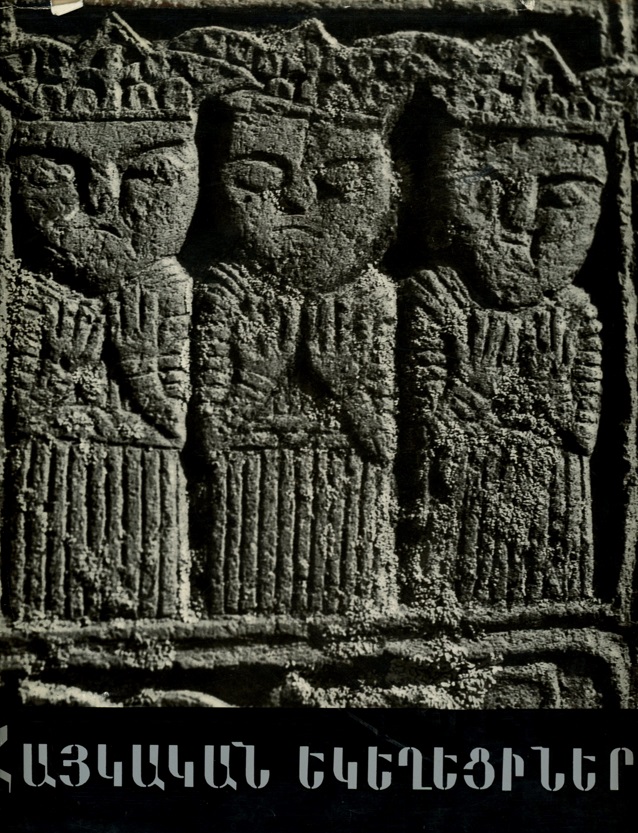 Rangement Beaux-livres
 | | Armenian Churches |
| Titre : | Armenian Churches / auteur(s) : Catalogues - |
|---|
| Editeur : | Holy See of Echmiadzin |
|---|
| Année : | 1970 |
|---|
| Imprimeur/Fabricant : | |
|---|
| Description : | 19 x 24,5 cm, 26 pages, jaquette illustrée n oir et blanc, nmbreuses photographies en noir et blanc |
|---|
| Collection : | |
|---|
| Notes : | A publication of The Calouste Gulbenkian Foundation Lisbon ; Trilingue arménien, anglais, russe |
|---|
| Autres auteurs : | |
|---|
| Sujets : | Armenian Churches |
|---|
| ISBN : | |
|---|
| Lecture On-line : | non disponible |
|---|
Commentaire : |
|